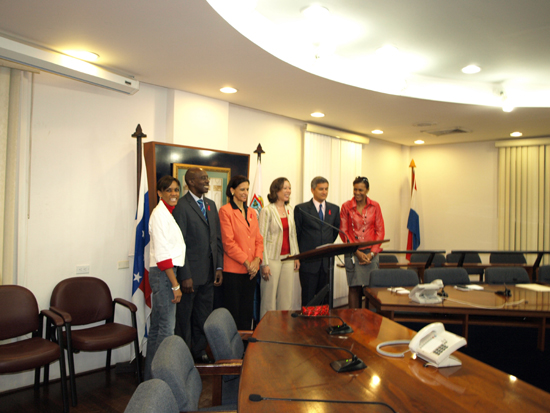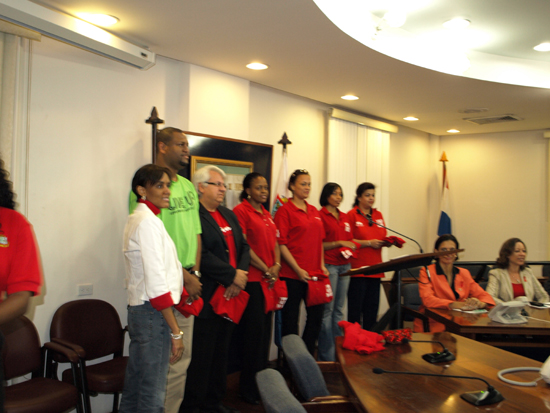 Philipsburg:----- St. Maarten has the highest amount of people living with HIV/AIDS within the Netherlands Antilles. The revelation was made yesterday at official ceremony in honor of World Aids Day by commissioner of health Maria Buncamper Molanus. "Because of this fact the infected the island and its people cannot afford to be complacent as there are thousands of people in the Netherlands Antilles live with the virus and it remains a major concern for our community in particular for one simple reason. St. Maarten has the largest amount of people with HIV/AIDS in the entire Netherlands Antilles. People have to be vigilant and to keep talking about the virus so that people don't drop their guard. Even though treatment is available at very high cost the main objective is to focus on prevention of HIV/AIDS.
Philipsburg:----- St. Maarten has the highest amount of people living with HIV/AIDS within the Netherlands Antilles. The revelation was made yesterday at official ceremony in honor of World Aids Day by commissioner of health Maria Buncamper Molanus. "Because of this fact the infected the island and its people cannot afford to be complacent as there are thousands of people in the Netherlands Antilles live with the virus and it remains a major concern for our community in particular for one simple reason. St. Maarten has the largest amount of people with HIV/AIDS in the entire Netherlands Antilles. People have to be vigilant and to keep talking about the virus so that people don't drop their guard. Even though treatment is available at very high cost the main objective is to focus on prevention of HIV/AIDS.Buncamper Molanus said the as St. Maarten join the world in marking the 20th milestone the community of St. Maarten has seen a fundamental change. No longer is it considered taboo when it comes to talking about the epidemic of HIV/AIDS. No longer is it subject of a whisper conversation. Various community groups, churches and other organizations are openly discussing HIV/AIDS with a focus on prevention.
This is exactly the kind of initiative is needed on St. Maarten to fight the spread of HIV/AIDS. She credited the dream team at the HIV/AIDS Program Management Department and the St. Maarten AIDS Foundation for raising the awareness level to unprecedented heights.
By now a large section of St. Maarten's population should be thinking red, talking red, discussing red, supporting red and hopefully living by the underlying principles of red.
 The RED Campaign was only the start of a number of programs that will either continue or commence in 2009.
The RED Campaign was only the start of a number of programs that will either continue or commence in 2009.
Additionally, the theme in 2009 will be "Talk Red, Do Safe" with a special focus on our youth. She said she welcome the attention that is placed on the youth as a survey among St. Maarten's young people recently indicated that a majority of youth had no basic knowledge of HIV/AIDS and some even thought a cure had already been found. These are worrisome results to say the least, the commissioner of health said.
Today's young people are the AIDS generation. They have never known a world without HIV. Yet the HIV/AIDS epidemic among young people remains largely invisible.
The Island Government recognizes that psychological and social attributes of adolescence make young people particularly vulnerable to HIV and other sexually transmitted infections. Adolescents often are not able to comprehend fully the extent of their exposure to risk. Buncamper- Molanus said she is looking forward to discussing, approving and participating in any comprehensive strategy that would decrease the risk to the island youths.
While Lt. Governor Franklyn Richards in his address said in keeping with theme for this year's World Aids Day which is "Leadership" and the slogan"Stop AIDS. Keep the Promise."
Leadership was selected as the theme for World AIDS Day to encourage leaders at all levels to stop AIDS. Building on the 2006 theme of accountability, leadership highlights the discrepancy between the commitments that have been made to halt the spread of AIDS, and actions taken to follow them through. The theme empowers everyone from individuals to organisations to governments to lead in the response to AIDS.
2008 marks the 20th anniversary of World AIDS Day. Since 1988, the face and response to AIDS has greatly changed. While many of these changes are positive, this anniversary offers us an opportunity to highlight how much more still needs to be done.
Leaders in most countries from around the world now acknowledge the threat of AIDS, and many have committed to do something about it. As of 2007, nearly all countries have national policies on HIV. However, despite these policies, most have not been fully implemented and many lack funding allocations, as is the case with the island territory of St. Maarten.
While treatment for HIV and AIDS has improved and become more widespread since 1988, many still do not have access to it - in 2007 only 31% of those in low- to middle-income countries who need treatment received it.
Despite HIV awareness now reaching nearly all areas of the globe, infection rates are still happening 2.7 times faster than the increase in number of people receiving treatment.
While the number of countries protecting people living with HIV continues to increase, one third of countries still lack legal protections and stigma and discrimination continues to be a major threat to universal access.
The number of people living with HIV is continuing to rise in every part of the world. There are now 33 million people living with HIV worldwide.
Last year, between 230,000 to 270,000 people were living with HIV/AIDS in the Caribbean, while 20,000 to 25,000 were newly infected.
At the end of 2007, an estimated 30,000 people with the disease were receiving antiretroviral treatment in the region - a 50 percent increase over 2006.
"We should take keen note that 38 people in the region die from AIDS-related causes daily and that 55 new HIV cases occur each day in the Caribbean." Richards said. According to the Caribbean Media Corporation, the Caribbean has the second highest HIV/AIDS prevalence rate worldwide after sub-Saharan Africa (Caribbean Media Corporation, 10/22).
According to the Caribbean Media Corporation, the Caribbean has the second highest HIV/AIDS prevalence rate worldwide after sub-Saharan Africa (Caribbean Media Corporation, 10/22).
Individuals must be empowered to access treatment, to know their rights and take action against stigma and discrimination, and to know and use methods of prevention against receiving and transmitting HIV!
Communities must demand and encourage leadership of its members! Now, more than ever is the time to lead - empower - deliver!
And so, we have no more time to waste about reaching the youth. Today's young people are tomorrow's journalists, politicians, teachers, scientists and employers. Schools have a vital role to play in getting their students talking about HIV so that they can safeguard their own sexual health and help to break down stigma and discrimination around HIV.
Leader of government Sarah Wescot-Williams also addressed the gathering before the official pinning ceremony and launching of the 2009 campaign. Project manager Suzette Burton Moses urged the community to use the information they were given during the Red Campaign, she said now is the time to think about that information and use it in the future.











